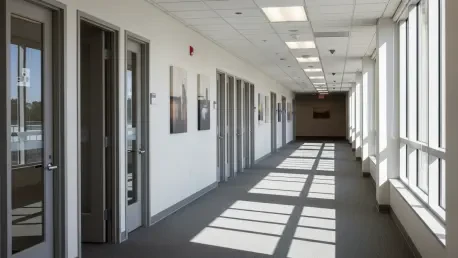The federal government has just endured a staggering 43-day shutdown, the longest in U.S. history, leaving agencies, contractors, and entire communities grappling with an unprecedented crisis that has disrupted lives and economies alike. Picture empty offices in Washington, D.C., where critical projects have stalled, and thousands of workers—both federal and contracted—have gone weeks without a paycheck. This historic disruption has not only halted essential services but also shaken the foundation of economic stability across the nation. What does it take to rebuild after such a prolonged standstill, and can recovery truly happen before another funding lapse threatens to strike?
A Nation Held Hostage: The Ripple Effects of a 43-Day Shutdown
The shutdown’s impact rippled far beyond the walls of government buildings, touching every corner of society. National parks closed their gates, food safety inspections slowed, and even tax refunds faced delays, leaving citizens frustrated and vulnerable. Small businesses near federal hubs saw plummeting revenue as unpaid workers tightened their budgets, illustrating how deeply intertwined government operations are with daily life.
Contractors, often the backbone of federal projects, found themselves in limbo with stop-work orders piling up. Many faced the harsh reality of unpaid invoices, unable to cover operational costs while waiting for the government to reopen. This cascading effect revealed a stark truth: a shuttered government doesn’t just pause—it paralyzes entire ecosystems dependent on its function.
The economic toll was immediate and severe, with early estimates suggesting billions in lost productivity. Beyond numbers, the human cost painted a grim picture, as families struggled to pay bills and workers questioned the security of their livelihoods. This crisis set the stage for a recovery process that promises to be as complex as the shutdown itself.
Why the Shutdown’s Impact Lingers On
Even with government doors reopening, the shadow of this 43-day ordeal looms large. Federal agencies are not simply flipping a switch to resume normalcy; they’re facing operational disruptions that could persist for months, if not years. The Congressional Budget Office (CBO) has reported a 1.5% reduction in quarterly GDP growth due to the shutdown, with an unrecoverable loss of $11 billion tied to unperformed work by furloughed employees.
Contractors, meanwhile, continue to navigate financial uncertainty, with payment delays disrupting cash flow throughout the supply chain. Adding to the tension is the specter of another funding lapse, as most agency budgets are secured only until late January. If Congress fails to act, the nation could face a repeat crisis before even scratching the surface of recovery, amplifying the stakes for all involved.
This isn’t merely a bureaucratic hiccup—it’s a national concern with far-reaching consequences. The intersection of economic damage and legislative gridlock underscores a critical need for solutions that address both immediate fallout and long-term stability. Without swift action, the path forward remains fraught with risk.
Challenges on the Road to Recovery
Rebuilding after such a prolonged shutdown is no small feat, as agencies and contractors confront a web of obstacles. Operational backlogs stand as a primary hurdle, with the Professional Services Council (PSC) estimating a recovery timeline of three to five days for each day of closure. This projection suggests full normalcy might not return until early 2027, a daunting horizon for those already stretched thin.
Financial strain compounds the issue, as unpaid invoices clog the system and disrupt payment flows to contractors and subcontractors alike. The economic fallout is equally stark, with job losses and reduced spending creating ripple effects across industries. While federal employees are slated for back pay, contract workers face a bleaker reality, with no guaranteed compensation for lost wages, highlighting a glaring disparity in recovery support.
Each challenge interlocks with the next, creating a puzzle that demands meticulous attention. Data from the CBO and industry insights paint a picture of a recovery process that will test resilience at every level. Agencies must navigate these hurdles with limited resources and under the constant threat of another shutdown, making efficiency and prioritization paramount.
Frontline Voices: Insights and Personal Struggles
To understand the true scope of this crisis, it’s vital to hear from those directly affected. The PSC has called on agencies to prioritize invoice processing and rescind stop-work orders, warning that delays could cripple contractors’ ability to rebound. Their plea underscores the urgency of restoring financial stability to a sector hit hard by the funding lapse.
White House National Economic Council Director Kevin Hassett has provided a sobering perspective, estimating a weekly economic cost of $15 billion during the shutdown, alongside job losses for 60,000 non-federal workers. These figures bring into sharp focus the broader implications of government inaction, extending pain well beyond federal corridors to private sector employees and their families.
On a personal level, stories of furloughed workers reveal the human toll. One contractor shared the anxiety of missing mortgage payments, uncertain if retroactive pay would ever come. Such accounts ground the staggering statistics in raw emotion, reminding all stakeholders that behind every delayed project or lost dollar is a person struggling to make ends meet.
Practical Strategies Amid Ongoing Uncertainty
Navigating recovery requires actionable steps tailored to the unique challenges of this shutdown’s aftermath. First, agencies must fast-track invoice processing and lift stop-work orders to stabilize contractor operations, a move strongly advocated by the PSC. This financial lifeline could prevent further economic bleeding and restore confidence in the supply chain.
Clear communication stands as another critical tool, with transparent updates between agencies, contractors, and Congress essential to combat misinformation. Additionally, preparing for potential volatility is non-negotiable; with funding for most agencies expiring soon, contingency plans for another shutdown must be drafted now to avoid repeating past mistakes.
Finally, addressing workforce inequities is vital. Pushing for policies that secure retroactive pay for contract workers could bridge the gap between federal and non-federal recovery experiences. These strategies, while not exhaustive, offer a roadmap for stakeholders to tackle immediate needs while bracing for uncertainties that lie ahead.
Reflecting on a Historic Disruption
Looking back, the 43-day shutdown carved a deep wound into the fabric of federal operations and economic stability. Agencies and contractors bore the brunt of operational chaos, while billions in unrecoverable losses reshaped national growth projections. The disparity between federal and contract workers’ compensation added a layer of inequity to an already painful chapter.
Personal stories of struggle intertwined with expert warnings, painting a comprehensive picture of a nation caught off guard. The looming threat of another funding lapse served as a constant reminder of unresolved legislative tensions. Each element of this crisis demanded attention, from backlogged invoices to shuttered services, leaving an indelible mark on public trust.
Moving forward, the focus must shift to proactive measures—streamlining financial processes, enhancing dialogue among stakeholders, and fortifying contingency plans. Beyond immediate recovery, there’s a pressing need to advocate for systemic reforms that prevent such prolonged disruptions. Only through sustained effort and collaboration can the groundwork be laid for a more resilient governmental framework, ensuring that history does not repeat itself.









